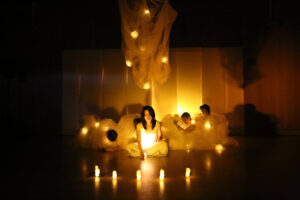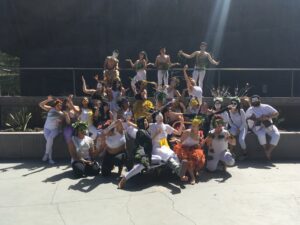LEIMAY LUDUS unfolds in artistic and academic residencies, taking shape as a creative methodology, research practice, and public engagement tool. Whether hosted by a cultural institution, museum, performance venue, or university, LUDUS integrates into residencies in multiple ways—as a training method, a movement research tool, an interdisciplinary lab, a site-responsive practice, and a public-facing experience.
During a residency, LUDUS can support and expand the artistic creation process, offering opportunities for ensemble training, community engagement, and knowledge-sharing. From intensive workshops and artist talks to open studios and site-specific activations, LUDUS creates a dynamic exchange between artists, institutions, and audiences.
How LUDUS is Activated in Residencies
LUDUS Training for the Ensemble & Artists
Residencies often include immersive training sessions for LEIMAY Ensemble members, guest artists, and collaborators, focusing on attunement, movement exploration, and the physical preparation of the body for artistic creation.
LUDUS as a Research Laboratory
LUDUS is an evolving practice that thrives in research-based residencies, integrating:
- Movement & Materiality Labs – Investigating the relationship between body, space, objects, and materials.
- Expanded Practices – Exploring wearables, kinetic sculptures, sound, and media in dialogue with movement.
- Interdisciplinary Experiments – Connecting movement with architecture, sculpture, technology, and visual arts.
LUDUS Community Engagement & Public Programs
When a residency includes a public component, LUDUS engages communities through:
- Workshops & Open Classes – Offering the public, students, and local artists an entry point into LEIMAY’s movement research.
- Lecture Demonstrations & Conversations – Providing insights into LEIMAY’s artistic process, methodologies, and interdisciplinary collaborations.
- Open Studios & Work-in-Progress Showings – Inviting audiences to witness and engage with the creative process in real time.
LUDUS in University Residencies
When hosted by a university, LUDUS becomes an educational and interdisciplinary tool, engaging students and faculty through:
- Semester-Long Courses & Intensives – Academic integration of LUDUS as an embodied research methodology.
- Collaborative Student Labs – Hands-on experiments merging movement, performance, and expanded media.
Repertory Training & Performance Creation – Students embodying and performing LEIMAY repertory or newly developed works.
Bring LUDUS to Your Residency Program
LEIMAY has developed residency-based LUDUS offerings at universities, museums, performance spaces, and cultural institutions. If you are interested in hosting a LEIMAY residency that integrates movement research, interdisciplinary creation, and/or public engagement, we offer customized residency models tailored to the needs of your space and community.
Contact us to explore how LUDUS can be part of your residency program!
In Person Event




